NEWS & NOTES

The Sruti Foundation honoured three distinguished personalities engaged in the arts on 21st August 2010 at the Bharatiya Vidya Bhavan in Mylapore:
- The E. Krishna Iyer Medal to senior dancer Vyjayantimala Bali.
- Vellore Gopalachariar Memorial award to veena vidushi Padmavathy Ananthagopalan, and
- M. Venkatakrishnan Memorial award to R. Krishnaswami, Secretary of Narada Gana Sabha and President of the Federation of Sabhas, Chennai.
The function started on an auspicious note with an invocation by young Aditya Prakash. This being the bicentennial of Vadivelu of the Tanjavur Quartet, Aditya rendered Kapaduvey a composition of the Quartet on Tanjai Brihadeesa in raga Anandabhairavi. Sruti Editor-in-Chief V. Ramnarayan gave a brief account of the history of these awards and extended a warm welcome to the gathering.
COVER STORY

FROM THE SRUTI ARCHIVES
The Lalgudi legacy (Part I of a profile of Lalgudi G. Jayaraman)
Lalgudi G. Jayaraman’s journey through the world of Carnatic music began in 1942, the year of his first public performance. Since then his passage has been that of a “bearded meteor trailing light”.
In a series of conversations 25 years ago, Jayaraman told Gowri Ramnarayan, then Assistant Editor, Sruti, that any self portrait of his on a new canvas would have to be ‘pentimento’ – revealing traces and outlines of other images and figures, of scenes from the past, of the forceful currents moulding his personality and shaping his destiny. He compared such reminiscence to a perusal of an old picture album, flipping through shifting phases of technique and creativity. “In retrospect I fully realise to what extent my originality and quest for perfection have given violin playing a new orientation and increased the instrument’s scope. I see clearly the extent of my growth, the changes affecting it, and the dynamic development of a new methodology.”
Sruti is happy to reproduce the original draft written by Gowri Ramnarayan in 1985 – slightly edited – on the occasion of the maestro’s 80th birthday on 17th September 2010.
Even his critics agree that Lalgudi G. Jayaraman is a member of the majestic triumvirate of master violinists, with contemporaries T.N. Krishnan and M.S. Gopalakrishnan. They will concede that this magician of string and bow forged striking innovations and renewed the bases of tradition. His imaginative essays were always anchored within the definitive ramparts of tradition. He has influenced the musicians of his own and succeeding generations, within and outside his own school.
GNB CENTENARY

Slings and arrows
In his Sangita Kalanidhi accep-tance speech, GNB said, “All cultural progress has been due to pioneers of new ideas and
expressions, though at their own times, they were called rebels.” True to his statement, he was himself first considered a rebel, but later accepted as a pioneer of his time. When he started his musical career, there was consensus that his career would be short-lived, what with his lack of formal training under the gurukula system and his dependence on an extraordinary voice and ability to sing at lightning speed.
GNB’s fame grew as he kept introducing innovations and offering attractive features of music to the listening public. He became the musician laureate of the Ettayapuram and Travancore principalities in the 1940s. An article by G. Kittappa
gave an interesting picture of his growth. He said, “The audience at a 1942-43 concert at Kali Studios, Calcutta, by GNB, T.N. Krishnan, Palghat Mani and Alangudi shouted out demands for a repeat performance – not an encore but a fresh concert altogether – after a brilliant tani following Kambhoji raga alapana and the kriti Ma Janaki. The honorarium for the kutcheri was 10,000 rupees! When the musicians returned to their room after the concert, the sabha officials swooped down on GNB and made him agree to a second concert in a few days’ time.”
MAIN FEATURE

Sowmya and her “Thatha”.
Well known Carnatic vocalist and teacher S. Sowmya received the Sangeeta Choodamani award on 7th August 2010 on the inaugural day of Sri Krishna Gana Sabha’s 55th Gokulashtami Sangeeta Utsavam. The award comprises a purse of one lakh rupees, a gold medal and a citation. Sowmya, who has a masters from IIT Madras in Chemistry, is also a gold medallist in M.A. (Indian Music) from the University of Madras. She is a “technomusician” –the producer and coauthor of an interactive, encyclopaedic
CD-ROM on Carnatic music titled Nadanubhava – The Horizons of Carnatic music and the tutoring VCD on Carnatic music titled Nadopasana – My Own Carnatic Tutor, a self-help guru with karaoke features. Sowmya dedicates her musical career to the two great musical personalities in her life – her guru-s Sangita Kalanidhi Dr. S. Ramanathan and T. Muktha.
I met Sowmya for this interview on the day before Navaratri began. A friend told me that her themed kolu-s were very popular. I entered her house in Valmiki Nagar to find a nearly-finished kolu – the theme for the year was ‘vahana’. From every corner of the room, vehicles, of various gods and goddesses, ordinary and curious, machine and beast, land, sea, air and space, mythical, ancient, contemporary and even speculative, of different sizes and shapes stared at me, and in the middle of it all was Sowmya, smiling, as she welcomed me, ‘I’m sorry about the mess. We will have to sit in that corner.”


